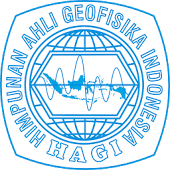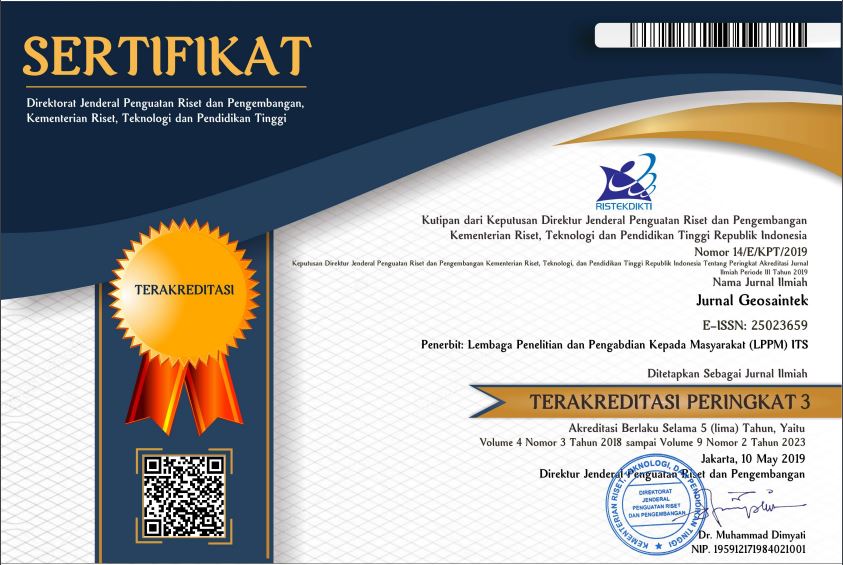PENDUGAAN POTENSI TINGKAT KOROSIFITAS LAPISAN BAWAH PERMUKAAN MENGGUNAKAN TEKNIK VERTICAL ELECTRICAL SOUNDING (Studi Kasus: Kabupaten Penajam, Kalimantan )
Abstract
Instalasi jaringan di bawah permukaan adalah hal yang sangat penting dan bermanfaat bagi suatu wilayah untuk mendistribusikan kebutuhan air, listrik, minyak, dan gas alam melalui pipa. Bahan logam biasanya dipilih karena memiliki kelebihan salah satunya dari segi kekuatan. Namun, kekurangan dari bahan logam adalah rentan mengalami korosi bila diinstalasi pada kondisi bawah permukaan yang kurang mendukung salah satunya akibat korosif tanah. Hal tersebut berbahaya bagi keselamatan dan keamanan lingkungan karena dapat menimbulkan terjadinya kebocoran pipa atau hal lainnya. Laju korosifitas tanah dipengaruhi oleh sifat fisik, listrik, kimia dari tanah, batuan, dan kandungan fluida di dalamnya. Resistivitas adalah salah satu variabel dari sifat listrik tanah yang berpengaruh besar terhadap laju korosifitas tanah. Solusi untuk mengestimasi nilai resistivitas tanah atau batuan yakni menggunakan metode geofisika geolistrik. Pengukuran 5 titik resistivitas dilakukan di wilayah Penajam, Kalimantan dengan menggunakan teknik Vertical Electrical Sounding (VES). Prosedur pengukuran resisitivitas berdasarkan American Standart Testing and Materials (ASTM) memakai Konfigurasi Wenner dengan 4 pin elektroda. Pengolahan data mengasilkan kurva resistivity sounding, model cross section, dan model konseptual geologi bawah permukaan. Perolehan galat hasil inversi dari kelima titik VES <10% sehingga interpretasi mengenai ketebalan, kedalaman, dan nilai resistivitas batuan mendekati kondisi aslinya. Litologi dari kelima titik VES pada kedalaman 0-40 meter diduga sebagai batu lempung yang mengandung mineral konduktif lebih banyak dengan nilai resistivitas 4.88-14.29 Ωm, batu lempung yang mengandung mineral konduktif lebih sedikit dengan nilai resistivitas 70.21-158 Ωm, dan batu pasir dengan nilai resistivitas 14.3-70.20 Ωm. Interpretasi tingkat korosifitas tanah berdasarkan National Association of Corrosion Engineers (NACE) dan ASTM menghasilkan pendugaan bahwa data VES 1, VES 2, VES 3, VES 4, dan VES 5 terdiri dari enam kelompok tingkat korosifitas tanah diantaranya sangat sedikit korosif/dapat diabaikan, sedikit korosif, cukup korosif, korosif, sangat korosif, dan paling korosif
Keywords
Korosifitas tanah, resistivitas, sounding Wenner
Full Text:
PDFReferences
Adeniji, A. E., Omonona, O. V., Obiora, D. N., & Chukudebelu, J. U. (2014), “Evaluation of soil corrosivity and aquifer protective capacity using geoelectrical investigation in Bwari basement complex area, Abuja”, Journal of Earth System Science, 123, 491-502.
Alzahra, S. R., Taryana, D., & Masitoh, F. (2021), “ Identifikasi lapisan akuifer Kawasan Dataran Suko Mulyo, Desa Suko Mulyo, Kecamatan Sepaku, Kabupaten Penajam Paser Utara, Kalimantan Timur”, Jurnal Integrasi dan Harmoni Inovatif Ilmu-Ilmu Sosial (JIHI3S), 1(11), 1239-1256.
Arriba-Rodriguez, L. D., Villanueva-Balsera, J., Ortega-Fernandez, F., & Rodriguez-Perez, F. (2018), “Methods to evaluate corrosion in buried steel structures: a review”, Metals, 8(5), 334.
ASTM D 6431–18. (2018). Standard guide for using the direct current resistivity method for subsurface investigation. ASTM International: West Conshohocken, PA.
ASTM G 57–20. (2020). Standard test method for field measurement of soil resistivity using the Wenner four-electrode method. ASTM International: West Conshohocken, PA.
ASTM G187-18. (2018). Standard Test Method for Measurement of Soil Resistivity Using the Two-Electrode Soil Box Method. ASTM International: West Conshohocken, PA.
Azmi, M. I. S., Madun, A., Malik, A. K. A., Sani, S., Dan, M. F. M., Tajudin, S. A. A., Talib, M. K. A., Pakir, F., & Sahdan, M. Z. (2021), “The effect of kaolinite and illite towards resistivity and chargeability value for groundwater survey”, In AIP Conference Proceedings, Vol. 2355, No. 1.
Bhandari, P. P., Dahal, K. P., & Bhattarai, J. (2013), “The corrosivity of soils collected from Araniko Highway and Sanothimi areas of Bhaktapur, Nepal”, Journal of Institute of Science and Technology, 18(1), 71-77.
Chen, C. H., Sheen, Y. N., & Wang, H. Y. (2016), “Case analysis of catastrophic underground pipeline gas explosion in Taiwan”, Engineering Failure Analysis, 65, 39-47.
Cong-Thi, D., Dieu, L. P., Thibaut, R., Paepen, M., Ho, H. H., Nguyen, F., & Hermans, T. (2021), “Imaging the structure and the saltwater intrusion extent of the Luy river Coastal Aquifer (Binh Thuan, Vietnam) using electrical resistivity tomography”, Water, 13(13), 1743.
Dhakal, Y. R., Dahal, K. P., & Bhattarai, J. (2014), “Investigation on the soil corrosivity towards the buried water supply pipelines in Kamerotar town planning area of Bhaktapur, Nepal”, Bibechana, 10, 82-91.
Ekhasomhi, A. G., Ehisuan, Y., & Ariavie, G. (2017), “Design of a cathodic protection system for 2,000 barrels crude oil surge tank using zinc anode”, J Multidiscip Eng Sci Technol, 4(3), 6905-6908.
Ekine, A., & Emujakporue, G. (2010), “Investigation of corrosion of buried oil pipeline by the electrical geophysical methods”, Journal of Applied Sciences and Environmental Management, 14(1).
Elarabi, H., & Elkhawad, T. (2014), “Evaluation of Subsoil Corrosivity Condition around Baracaia Area using the Electrical Resistivity Method, A Case Study from the Muglad Basin, Southwestern Sudan”, Journal of Earth Science and Engineering, 4(5).
Jusoh, H., & Osman, S. B. S. (2017), “The correlation between resistivity and soil properties as an alternative to soil investigation”, Indian Journal of Science and Technology, 10(6), 1-5.
Li, J., Sun, C., Shuang, S., Roostaei, M., Fattahpour, V., Mahmoudi, M., & Luo, J. L. (2019), “Investigation on the flow-induced corrosion and degradation behavior of underground J55 pipe in a water production well in the Athabasca oil sands reservoir”, Journal of Petroleum Science and Engineering, 182, 106325.
Loke, M. H. (1999), Electrical imaging surveys for environmental and engineering studies, A practical guide to 2-D and 3-D surveys.
Maurya, P. K., Rønde, V. K., Fiandaca, G., Balbarini, N., Auken, E., Bjerg, P. L., & Christiansen, A. V. (2017), “Detailed landfill leachate plume mapping using 2D and 3D electrical resistivity tomography-with correlation to ionic strength measured in screens”, Journal of Applied Geophysics, 138, 1-8.
Olawuyi, A. K., & Abolarin, S. B. (2013), “Evaluation of vertical electrical sounding method for groundwater development in basement complex terrain of west-central Nigeria”, Nigerian Journal of Technological Development, 10(2), 22-28.
Oldenburg, D. W., Kang, S., Heagy, L. J., & Maxwell, M. (2022), Direct current resistivity methods, In Engineering Geophysics (pp. 67-75). CRC Press.
Santosan, L. W., & Adji, T. N. (2018), Karakteristik Akuifer dan Potensi Airtanah Graben Bantul, UGM PRESS.
Susiati, H., Kusuma, H. D., Hartono, H. G., & Sriyana, S. (2018), “Identifikasi Geologi Lingkungan Pada Evaluasi Tapak Fasilitas Nuklir BNI-STP, Penajam Paser Utara”, Jurnal Pengembangan Energi Nuklir, 19(2), 69-79.
Vasantrao, B. M., Bhaskarrao, P. J., Mukund, B. A., Baburao, G. R., & Narayan, P. S. (2017), “Comparative study of Wenner and Schlumberger electrical resistivity method for groundwater investigation: a case study from Dhule district (MS), India”, Applied Water Science, 7, 4321-4340.
Wahyuningsih, U., Rusjdi, H., dan Sulistiyo, E. (2017), “Penanggulangan Korosi Pada Pipa Gas dengan Metode Catodic Protection (Anoda Korban) PT PGN Solution Area Tangerang”, Jurnal Powerplant, 5(1), 40-50.
Wirama, I. W. P., Astika, I. M., & Subagia, I. A. (2021), “Uji kekuatan bending pipa komposit jute-epoxy pada perlakuan rendaman air panas“, Jurnal Energi dan Manufaktur Vol, 14(2), 72-75.
Zainal, M., & Marwan, M. (2019), “A Field Survey of Soil Corrosivity Based on Electrical Resistivity Method”, Journal of Aceh Physics Society, 8(1), 16-21.
DOI: http://dx.doi.org/10.12962%2Fj25023659.v9i3.19247
Refbacks

Jurnal Geosaintek diterbitkan oleh ITS bekerja sama dengan Himpunan Ahli Geofisika Indonesia (HAGI)
Disebarluaskan di bawah Lisensi Creative Commons Atribusi-BerbagiSerupa 4.0 Internasional.
Berdasarkan ciptaan pada https://iptek.its.ac.id/index.php/geosaintek/index.





